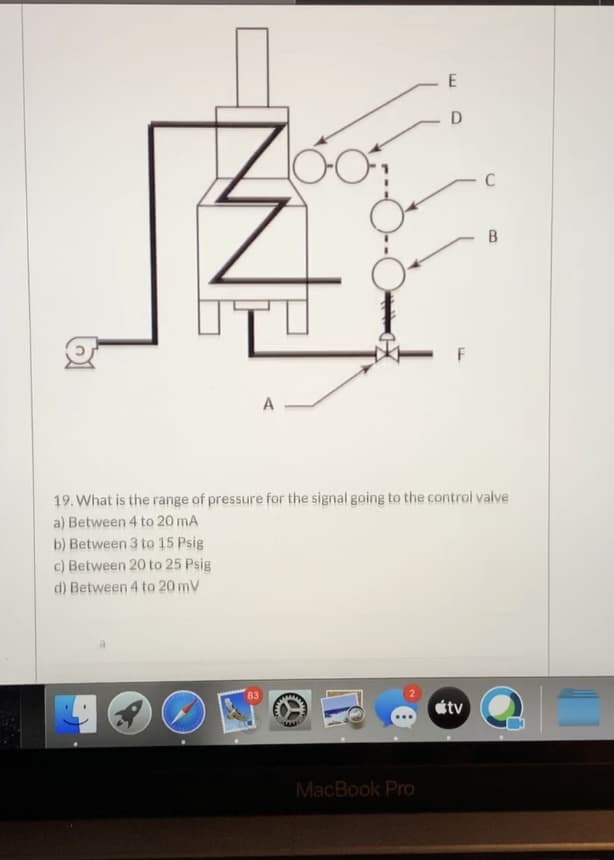19. What is the range of pressure for the signal going to the control valve a) Between 4 to 20 mA b) Between 3 to 15 Psig c) Between 20 to 25 Psig d) Between 4 to 20 mV 83 tv MacBook Pro
19. What is the range of pressure for the signal going to the control valve a) Between 4 to 20 mA b) Between 3 to 15 Psig c) Between 20 to 25 Psig d) Between 4 to 20 mV 83 tv MacBook Pro
Automotive Technology: A Systems Approach (MindTap Course List)
6th Edition
ISBN:9781133612315
Author:Jack Erjavec, Rob Thompson
Publisher:Jack Erjavec, Rob Thompson
Chapter8: Preventive Maintenance And Basic Services
Section: Chapter Questions
Problem 1RQ: Describe the information found in a VIN.
Related questions
Question
100%
I know that my answer b. was correct. But for future references, how do I know for sure the Psig range in a question like this?

Transcribed Image Text:19. What is the range of pressure for the signal going to the control valve
a) Between 4 to 20 mA
b) Between 3 to 15 Psig
c) Between 20 to 25 Psig
d) Between 4 to 20 mV
83
tv
MacBook Pro
Expert Solution
This question has been solved!
Explore an expertly crafted, step-by-step solution for a thorough understanding of key concepts.
This is a popular solution!
Trending now
This is a popular solution!
Step by step
Solved in 2 steps

Knowledge Booster
Learn more about
Need a deep-dive on the concept behind this application? Look no further. Learn more about this topic, mechanical-engineering and related others by exploring similar questions and additional content below.Recommended textbooks for you

Automotive Technology: A Systems Approach (MindTa…
Mechanical Engineering
ISBN:
9781133612315
Author:
Jack Erjavec, Rob Thompson
Publisher:
Cengage Learning

Refrigeration and Air Conditioning Technology (Mi…
Mechanical Engineering
ISBN:
9781305578296
Author:
John Tomczyk, Eugene Silberstein, Bill Whitman, Bill Johnson
Publisher:
Cengage Learning

Automotive Technology: A Systems Approach (MindTa…
Mechanical Engineering
ISBN:
9781133612315
Author:
Jack Erjavec, Rob Thompson
Publisher:
Cengage Learning

Refrigeration and Air Conditioning Technology (Mi…
Mechanical Engineering
ISBN:
9781305578296
Author:
John Tomczyk, Eugene Silberstein, Bill Whitman, Bill Johnson
Publisher:
Cengage Learning